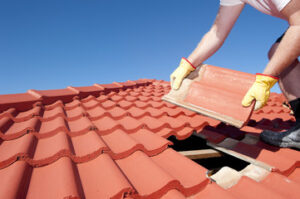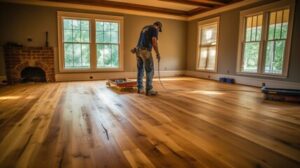Cabinet Refinishing Modesto Anchor is an effective way to transform the look of your kitchen or bathroom. It’s also a great option if you want to make a color change.

Refacing and resurfacing are often confused with cabinet refinishing, but they are quite different. Refacing changes your cabinet door style, material and hardware and resurfaces the cabinet boxes.
Cabinet staining is a simple way to give a kitchen a fresh, natural wood look. Unlike painting, staining preserves the grain of the wood and will not chip or peel. Staining is also less expensive than replacing cabinets or adding a new coat of paint. However, before you start staining, it’s important to make sure the existing finish is in good condition. Staining can easily chip if the existing finish is damaged, so it’s crucial to prep properly before you begin.
The first step to staining your cabinets is to thoroughly clean all surfaces with mineral spirits. Wearing latex gloves, dampen a cotton cloth or microfiber towel with mineral spirits then wipe down the cabinet doors and drawer fronts. Pay special attention to areas where handles and knobs are located, as they tend to be especially dirty and greasy. After cleaning, wipe away any lingering sanding dust with a dry rag or tack cloth.
Next, lightly sand the surfaces to create a smooth surface that will adhere well to the new stain. Using a sheet sander is best for flat sections, but a hand sanding block will work well on any textured or molded areas. Once sanded, use a brush attachment to vacuum up the majority of the remaining dust and then wipe down the cabinets with a tack cloth again.
Before staining, test a small area of the color on a piece of scrap wood to ensure it will look as desired in your space. After that, you can apply the first coat of stain. When applying, always remember to work with the grain of the wood and to be patient. Applying too much stain at once can lead to a sticky, uneven surface that will not dry correctly.
Once your stain is completely dry, it’s time to install the cabinet doors and drawer fronts back into their original locations. If you have a lot of cabinet doors, consider labeling them with numbers before removing them to simplify the reinstallation process later on. Be sure to also remove any hardware like hinges and screws from the doors and place them in a baggie for reinstallation.
Painting
Painting is one of the easiest upgrades to give your kitchen an entirely new look. However, it takes a lot of time and effort to do well. Most paint products were not designed to withstand constant contact with hands and fingers, nor the repeated opening and closing of cabinet doors. As a result, even the best cabinet painting jobs start to show wear within two or three years. If you’re looking for a long-lasting update, refacing is a better option.
Before starting your cabinet refinishing project, make sure all surfaces are free of grease and oils, which prevent the new paint from adhering properly. Clean the cabinets with a degreaser solution or trisodium phosphate (TSP), and then scrub them thoroughly. After cleaning, wipe down all surfaces and wait for them to dry completely. It’s also a good idea to label each cabinet door so that they’re returned in the same spot when the job is complete.
After scrubbing and cleaning the cabinets, it’s time to prep them for paint. Lightly sand all surfaces with a foam sanding block to give the primer something to bond to. Be careful not to sand too much, as this can damage the wood. Once the surface is sanded, dust it down with a tack cloth and vacuum it to remove any leftover debris.
Once the wood is dust-free and ready to be painted, prime all surfaces with high-quality oil-based primer. Allow the primer to dry overnight before applying a second coat. Then, after sanding once more, it’s time to apply the topcoat of paint. Start by coating the back of each cabinet door, then flip them over to coat the fronts. When painting the cabinet boxes, work in a ventilated area to avoid any overspray.
When painting cabinets, it’s important to follow the grain and tip-off your brush when applying each coat. This technique makes it easy to cover the entire surface without visible “smears.” After each coat, sand again with a fine grit sandpaper and vacuum once more. It’s a good idea to keep an extra set of brushes on hand for small touch-up areas as they may be necessary at some point.
Repairing
If you’re on a tight budget and want to give your kitchen cabinets a facelift, you can opt for cabinet refinishing instead of replacing or refacing them. The refinishing process is much less invasive and can be completed within a few days. It involves stripping the existing stain or paint and applying a new one. The cabinet refinishing process works on all wood materials, including solid wood and engineered wood like medium-density fiberboard (MDF). It’s also ideal for homeowners who aren’t ready for a complete overhaul and only want to change the color or finish of their cabinet doors and drawer fronts.
Aside from cosmetic damage, such as scratches or gouges, you may notice that your cabinet hinges are loose or not functioning properly. This is because the screws on cabinet hinges can get loose over time, especially if they’re frequently used or exposed to moisture. Loose hinges can cause doors to slam closed and damage the door frame or cabinet structure in the process.
The best way to repair loose cabinet hinges is by rescrewing them. This should be done by a professional as it requires the use of a power tool to remove the old screw and to apply the new screw. Using a screwdriver isn’t recommended as it can cause permanent damage to the cabinet hinges and the surrounding cabinet.
After screwing the hinges, you can begin preparing the surface to refinish or paint by sanding it. The sanding is important to ensure that the new stain or paint will adhere. Once the sanding is complete, you can apply the first coat of paint. It’s recommended to apply at least two coats of paint for a smoother, longer-lasting finish.
If you have a limited budget but want to give your kitchen cabinets a visual upgrade, consider cabinet refinishing. This is a less expensive option that can be completed in just one day. While refacing and refinishing are similar, refacing is more extensive than refinishing. It changes the appearance of your cabinets and alters their structural integrity. This is perfect for homeowners who want a style overhaul and would benefit from features like soft-close hinges.
Cleaning
Cabinets grab onto more grease, food particles, dirt, smoke, and grime than most other parts of your home. Fortunately, with a little effort, you can keep your cabinets looking spick and span. Dust them regularly with a lint-free cloth or duster, and clean spills and splatters as soon as they happen. This prevents them from hardening and makes cleaning them much easier.
Use a sponge or washcloth and a mild soap to wipe away grease, food residue, and smudges. Make sure to scrub in the direction of the wood grain to avoid scratching. If the stains persist, try making a paste of baking soda and water (adding more water as needed for an icing consistency) and rub it into the greasy spots. Then, rinse and dry the surfaces thoroughly to avoid spotting.
If you have thermofoil cabinets, a light waxing once a year can help protect them from grease and moisture. A wax coating also helps to repel water and oil, so it’s a good idea to apply it right after cleaning.
For tougher stains, you can use a little trisodium phosphate (TSP) mixed with warm water. TSP emulsifies grease, so it’s much easier to remove than soap and water alone. Be very careful using TSP in your kitchen, though — it’s extremely toxic when ingested or absorbed through the skin, so follow all safety precautions when applying this product.
Alternatively, you can try rubbing your cabinets with 3% hydrogen peroxide mixed with warm water. This also emulsifies grease and will remove stubborn stains from most wood finishes, including painted ones. After scrubbing, be sure to use a microfiber towel to soak up all the excess water before drying the surface.
If your cabinets are really stuck in a rut, consider hiring a professional. They’ll have the tools and equipment to safely sand and prep your cabinets for refinishing. They can also use new cabinet hardware to give your kitchen a fresh look and breathe some life into old, outdated cabinets. Before you start the process, be sure to label each piece of hardware to ensure it gets reattached properly when the time comes for reassembly.

